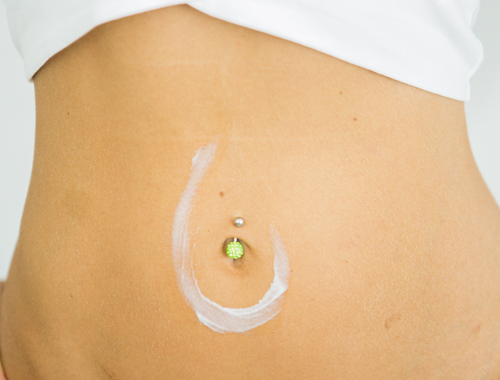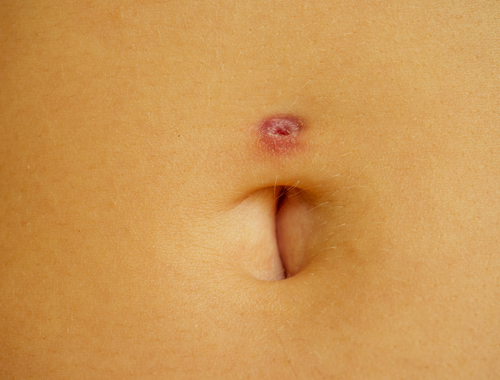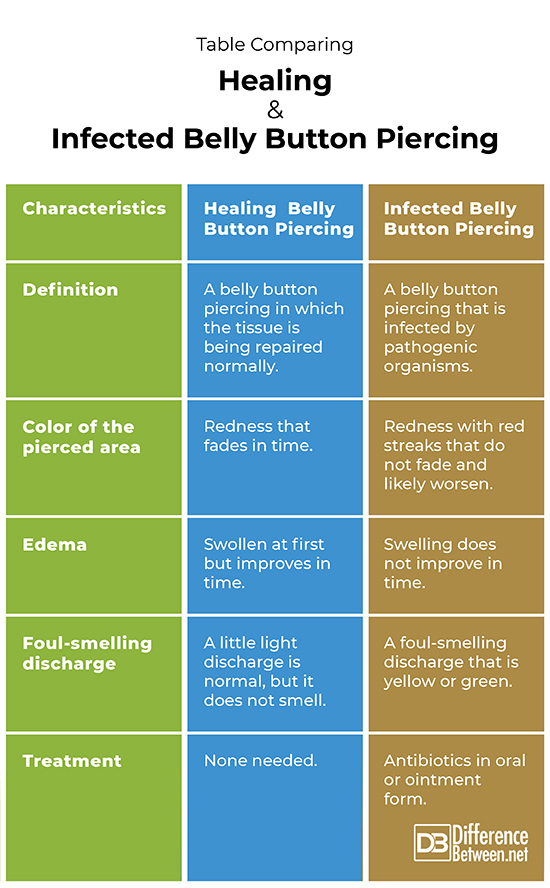Difference Between Healing and Infected Belly Button Piercing
A healing belly button piercing is when the normal process of repair of tissue occurs, while an infected piercing is one where bacteria have invaded the pierced area, causing infection.

What is a Healing belly button piercing?
Definition:
A healing belly button piecing is when the area is healing correctly after the piercing.
Process:
A normal healing process is important after you have had a piercing. The process involves a number of steps. The first stage of healing is inflammation, which is normal after the skin has been injured. The inflammatory response includes immune system cells arriving at the site and working with growth factors to help in healing. The proliferation stage occurs next and is when new connective tissue and blood vessels are laid down, and the wound contracts. The final stage of maturation is when new collagen is deposited, and the tissue gets back its original strength and flexibility. It can take up to one year for a belly button piercing to heal.
Signs and complications:
A clot will have formed after the bleeding, which happens immediately after the piercing. For about 48 hours after the piercing, the area may be red and swollen due to inflammation, but this will improve in time. Once healing is complete, the hole of the pierced area will be pink and have smooth edges. There will be no complications if a piercing heals correctly.
Treatment:
To ensure the piercing heals, you need to gently wash it once or twice a day. A piercing that is healing normally requires no treatment.

What is an Infected belly button piercing?
Definition:
An infected belly button piercing is when a pathogenic organism, such as a bacterium, invades and infects your pierced area.
Process:
A piercing can become infected if the area is exposed to dirt or pathogens entering the wound. The pathogens are often bacteria like Staphylococcus aureus. Once bacteria enter an area, they can multiply and destroy cells and tissues and even spread to other organs.
Signs and complications:
The signs that you have an infected belly button piercing include the following: pain at the site that does not go away, redness and swelling, a foul-smelling discharge that is yellow, green or brown at the site of the piercing, fever, nausea, vomiting, red coloring and streaks extending from the wound. Infectious endocarditis, in which the bacteria spread to the heart valves, is a common complication of an infected piercing.
Treatment:
The doctor can prescribe an oral antibiotic ointment to put on the wound. One antibiotic ointment that is often used is mupirocin. Oral antibiotics may also be needed if the infection is severe; Clindamycin and cephalexin are frequently used to treat bacterial infections of the piercing.
Difference between Healing and Infected belly button piercing?
Definition
A healing belly button piercing is one in which the tissue is being repaired normally. An infected belly button piercing is one in which the tissue is infected with bacteria.
Color of the pierced area
A healing belly button piercing will be red but will improve in time and fade. An infected piercing will be red, the redness will increase, and streaks will develop.
Edema
The swelling of a pierced belly button will decrease if it is healing. The swelling of an infected belly button piercing will not improve and may worsen.
Foul-smelling discharge
In the case of a healing pierced belly button, only a little discharge may occur, and it will not smell. In the case of an infected pierced belly button, the discharge will be green, yellow or brown, and it will smell foul.
Treatment
No treatment is needed if a belly button piercing is healing. If a belly button piercing is infected, then antibiotics in the form of pills or ointments is needed to kill the bacteria causing the infection.
Table comparing Healing and Infected belly button piercing

Summary of Healing Vs. Infected belly button piercing.
- A healing belly button piercing means that the tissue in the area of the piercing is repairing itself.
- An infected belly button piercing needs to be treated with antibiotics because the bacteria causing the infection can lead to dangerous complications.
FAQ
How do you tell if your belly button piercing is infected or rejecting?
An infected belly button piercing is often red, swollen, and has a foul discharge. It also feels hot when you touch it.
What does it look like when your belly piercing is infected?
The area is swollen and red.
How do you know if a piercing is healing or infected?
A piercing that is healing will not have a foul discharge, and the redness and swelling will improve in time.
Will an infected piercing heal itself?
A mild infection may improve in time, but it is safer to go to a doctor to see if antibiotics may be needed, as the complications can be severe.
How long does an infected belly piercing take to heal?
It can take as long as 9 months to a year for an infected belly piercing to completely heal.
How do you cure an infected belly button?
Antibiotic ointments and sometimes also oral antibiotics can help cure an infection of a belly button.
- Difference Between Rumination and Regurgitation - June 13, 2024
- Difference Between Pyelectasis and Hydronephrosis - June 4, 2024
- Difference Between Cellulitis and Erysipelas - June 1, 2024
Search DifferenceBetween.net :
Leave a Response
References :
[0]Mayo Clinic. “Piercings: How to prevent infections.” (2022). https://www.mayoclinic.org/healthy-lifestyle/adult-health/in-depth/piercings/art-20047317
[1]Preslar, Dayton, and Judith Borger. "Body Piercing Infections." (2019). https://www.ncbi.nlm.nih.gov/books/NBK537336/
[2]Weinberg, Jason B., and R. Alexander Blackwood. "Case report of Staphylococcus aureus endocarditis after navel piercing." The Pediatric infectious disease journal 22.1 (2003): 94-96.
